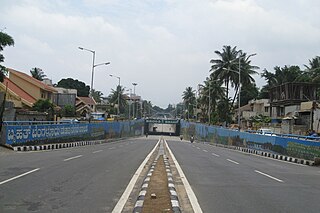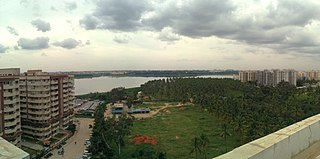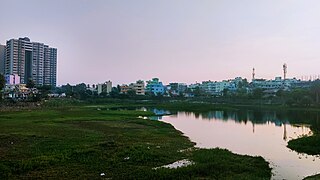The Birdwatchers' Field Club of Bangalore is a birdwatching club in Bangalore founded in the 1970s.

Whitefield is a suburb of Bangalore in the state of Karnataka, India. Established in 1882 as a settlement for the Eurasians and Anglo Indians of Bangalore, Whitefield remained a quaint little settlement at the eastern periphery of Bangalore city till the late 1990s when the local IT boom turned it into a major suburb. It is now a major part of Greater Bangalore. Whitefield is Bengaluru's first tech corridor to be connected by Namma Metro.

Sankey tank, a manmade lake or tank, is situated in the western part of Bangalore in the middle of the neighbourhoods of Malleshwaram, Vyalikaval and Sadashivanagar. The lake covers an area of about 15 ha. At its widest, the tank has a width of 800 m (2,624.7 ft).

Kolleru Lake is one of the largest freshwater lakes in India and forms the largest shallow freshwater lake in Asia. 15 kilometers away from Eluru and 65 km from Rajamahendravaram, the lake is located between the Krishna and Godavari river deltas. Kolleru Lake is located in the Eluru district in the state of Andhra Pradesh. The lake is fed directly by water from the seasonal Budameru and Tammileru rivulets, and is connected to the Krishna and Godavari irrigation systems by over 67 major and minor irrigation canals. This lake is a major tourist attraction. Many birds migrate here in winter, such as Siberian crane, ibis, and painted storks. The lake was an important habitat for an estimated 20 million resident and migratory birds, including the grey or spot-billed pelican. The lake was declared as a wildlife sanctuary in November 1999 under India's Wildlife Protection Act of 1972, and designated a wetland of international importance in November 2002 under the international Ramsar Convention. The wildlife sanctuary covers an area of 308 km2.

Lalbagh Botanical Garden or simply Lalbagh, is a botanical garden in Bangalore, India, with an over 200-year history. First planned and laid out during the dalavaiship of King Hyder Ali, the garden was later managed under numerous British Superintendents before Indian Independence. It was responsible for the introduction and propagation of numerous ornamental plants as well as those of economic value. It also served a social function as a park and recreational space, with a central glass house dating from 1890 which was used for flower shows. In modern times, it hosts two flower shows coinciding with the week of Republic Day and Independence Day. As an urban green space along with Cubbon Park, it is also home to numerous wild species of birds and other wildlife. The garden also has a lake adjoining a large rock on which a watchtower had been constructed during the reign of Kempegowda II.

Bannerghatta Road is an Indian State Highway in Karnataka. It connects Bangalore with the towns of Bannerghatta, Jigani, and Anekal. It extends for 49 kilometres (30 mi). It starts as a branch from Hosur Road near the Adugodi Christian Cemetery and ends at Anekal.
Puttenahalli WS Lake also spelled as Puttanahalli Lake is a 10-hectare water body near Yelahanka, 14 km north of Bangalore.

Puttenahalli is a suburban area in Bangalore, Karnataka State in India.

Madiwala lake is one of the biggest lakes in Bangalore, India spread over an area of 114.3 hectare. The water in the lake was fit for drinking till the early 1990s. Since then it has become unfit for drinking due to industrial waste and sewage entering the waterbody. It has gradually become polluted.
Lakes and tanks in the metropolitan area of Greater Bangalore and the district of Bangalore Urban are reservoirs of varying sizes constructed over a number of centuries by various empires and dynasties for rainwater harvesting. Historically, these reservoirs were primarily either irrigation tanks or for the water supply, with secondary uses such as bathing and washing. The need for creating and sustaining these man-made dammed freshwater reservoirs was created by the absence of a major river nearby coupled with a growing settlement. As Bangalore grew from a small settlement into a city, both of the primary historical uses of the tanks changed. Agricultural land witnessed urbanization and alternate sources of water were provisioned, such as through borewells, piped reservoir water and later river water from further away.

Bellandur Lake is located in the suburb of Bellandur in the southeast of the city of Bengaluru. It is the largest lake in the city. It is a part of Bellandur drainage system that drains the southern and the south-eastern parts of the city. The lake is a receptor from three chains of lakes upstream, and has a catchment area of about 148 square kilometres. Water from this lake flows further east to the Varthur Lake, from where it flows down the plateau and eventually into the Pinakani river basin.

Agara lake is an 80-acre lake located in Agara, Bangalore. It is part of the Varthur lake series. Madiwala Lake is upstream while Bellandur Lake is downstream. Inter-lake connections have seen fragmentation and urbanisation.
Yelahanka Lake is a water body near Yelahanka, a suburb of Bangalore.

Puttenahalli lake is a small, restored freshwater lake located in JP Nagar 7th Phase, South Bangalore. The area of the lake is about 13 acres. The primary water sources are rain and surface water diverted to the lake through channels. The lake is currently maintained by Puttenahalli Neighbourhood Lake Improvement Trust (PNLIT) . The lake was on the brink of extinction, but due to the efforts of PNLIT, is now a haven for bird-watchers and on its way to being completely restored.

The Thurahalli Forest or Thurahalli Park is a dry and deciduous forest. It is located about 20 km from Bengaluru off Kanakapura Road. It is 13 km from Banashankari and can be overseen from the NICE road. Entry inside the park has been banned for vehicles, however, it has become a hot spot for cyclists.
Arekere Lake is situated in the Arekere - Hulimavu area of the city of Bangalore. Originally spread over an area of approximately 37 acres, the lake is bounded on the west by Bannerghatta Road, on the north by BDA Eighty Feet Road, on the east by Shantinikethan Layout and on the south by Hulimavu Main Road. According to the BBMP website, the perimeter of the lake is about 3 kilometres (1.9 mi). It was possibly a manmade water reservoir created approximately 100 years ago.
Central Prison, Bangalore is the largest prison in the Indian state of Karnataka. Established in 1997, it became the central prison of Bangalore in 2000 when the old jail, which has since been converted to Freedom Park, was shut for renovation.
The Lake Development Authority (LDA) in Bangalore, Karnataka, and its successor the Karnataka Lake Conservation and Development Authority (KCLDA) were formed in 2002 and 2015 respectively. Karnataka Tank Conservation and Development Authority (KTCDA) under the Minor Irrigation Department became the superseding agency.
Jaraganahalli Lake was a lake in the southern part of Bengaluru, India.

Yele Mallappa Shetty Lake is one of the largest lakes in Bangalore, located on the eastern side of the city, outside of KR Puram. It is an artificial water reservoir constructed in early 1900s. The lake is spread over 490 acres (198.3 ha).













